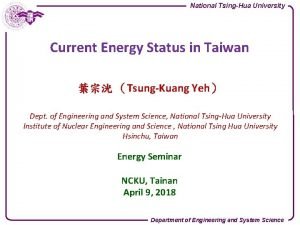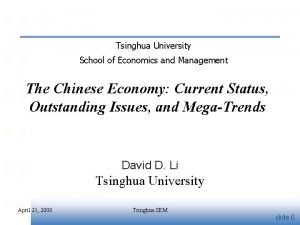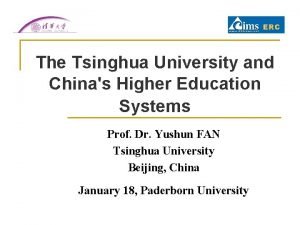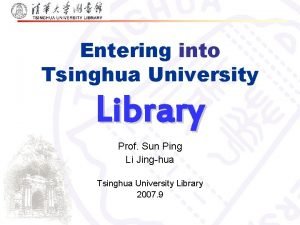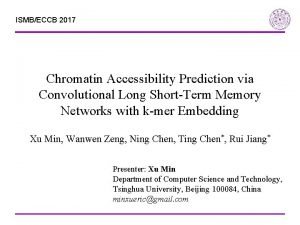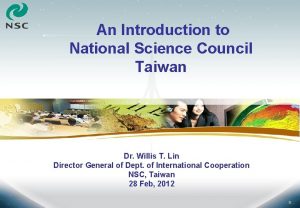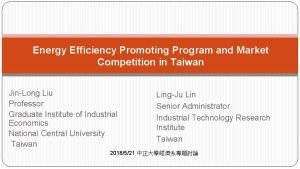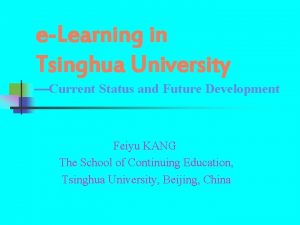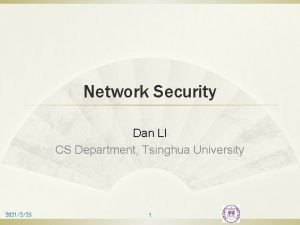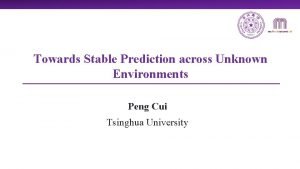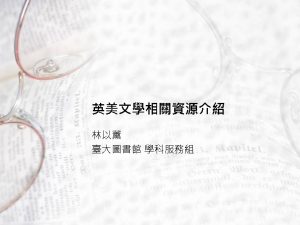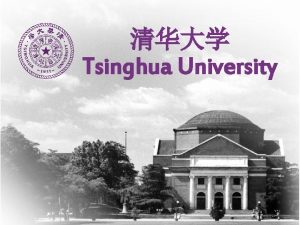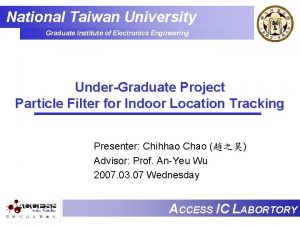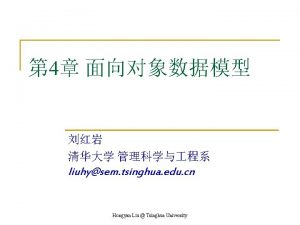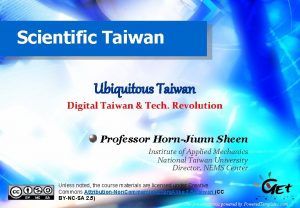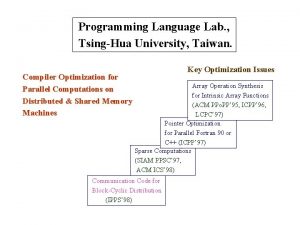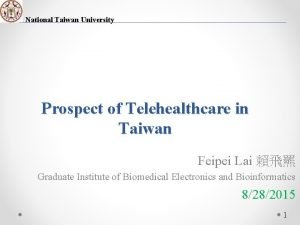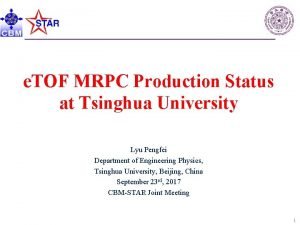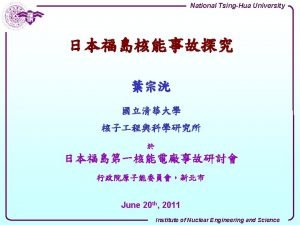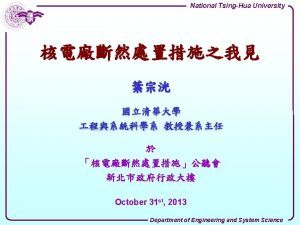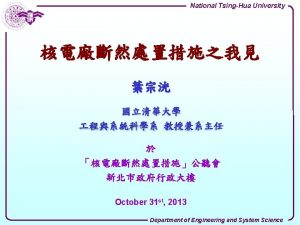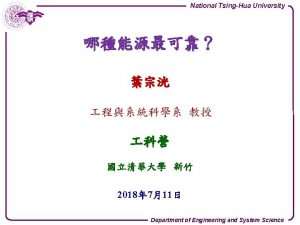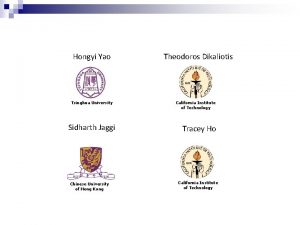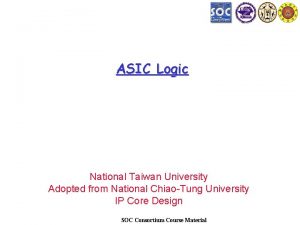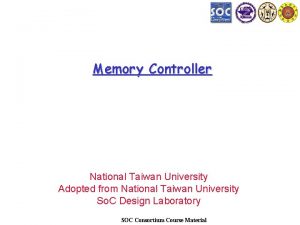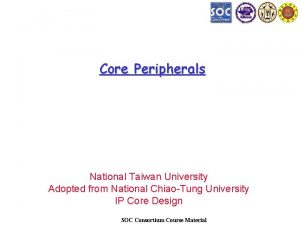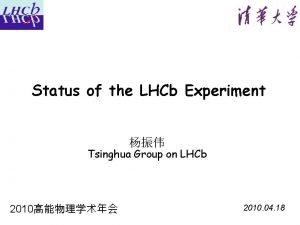National TsingHua University Current Energy Status in Taiwan

























- Slides: 25

National Tsing-Hua University Current Energy Status in Taiwan 葉宗洸 (Tsung-Kuang Yeh) Dept. of Engineering and System Science, National Tsing-Hua University Institute of Nuclear Engineering and Science , National Tsing Hua University Hsinchu, Taiwan Energy Seminar NCKU, Tainan April 9, 2018 Department of Engineering and System Science

National Tsing-Hua University OUTLINE 1. Foreword 2. Current Status of Licensed Nuclear Power Plants 3. Mothballed Units and Nuclear Share in Electricity 4. Energy Security 5. Statistics in 2016 6. Conclusions Department of Engineering and System Science

National Tsing-Hua University 1. Foreword(1/9) The Magic Number of 2025! u A nuclear-free homeland by 2025 u Increase in electricity generation by renewable energy from 5% in 2016 to 20% by 2025 u Electricity shares of 50% by natural gas, 30% by coal, and 20% by renewables by 2025 Photo Source: https: //kamonohashikamo. wordpress. com/2012/05/11/taipei-101 -tower/ Department of Engineering and System Science

National Tsing-Hua University 1. Foreword(2/9) The Cruel Facts in 2017 (1/4) u Serious electricity shortage with <6% reserved capacity island wide u A massive power blackout in August u Serious air pollution forced power reduction in coal-fire plants u Electricity shares by nuclear down from 19% to 9. 3% in 3 years Photo Source: https: //kamonohashikamo. wordpress. com/2012/05/11/taipei-101 -tower/ Department of Engineering and System Science

National Tsing-Hua University 1. Foreword(3/9) The Cruel Facts in 2017 (2/4) u Record-high electricity demand 231. 1 bn k. W-hr, a 5. 3 bn k. W-hr increase from 2016 u A costly decision to follow the footstep of Germany 5% to 20% renewables in 12 yrs in Germany; 5% to 20% in 8 yrs from 2018 to 2025 in Taiwan Photo Source: https: //kamonohashikamo. wordpress. com/2012/05/11/taipei-101 -tower/ Department of Engineering and System Science

National Tsing-Hua University 1. Foreword(4/9) The Cruel Facts in 2017 (3/4) Source: 台灣電力公司 Department of Engineering and System Science

National Tsing-Hua University 1. Foreword(5/9) The Cruel Facts in 2017 (4/4) Department of Engineering and System Science

National Tsing-Hua University 1. Foreword(6/9) Department of Engineering and System Science

National Tsing-Hua University 1. Foreword(7/9) Department of Engineering and System Science

National Tsing-Hua University 1. Foreword(8/9) Department of Engineering and System Science

National Tsing-Hua University 1. Foreword(9/9) q The largest coal-fired plant is located in Taichung, Taiwan with a total installed capacity of 5, 780 MW. Source: http: //www. taiwanese-secrets. com/geography-of-taiwan. html Department of Engineering and System Science

National Tsing-Hua University 2. Current Status of Licensed Nuclear Power Plants(1/5) Chinshan Kuosheng Maanshan *Adapted from Taipower Website at http: //www. taipower. com. tw/Taipower. Web//upload/images/11/powerimage. gif Department of Engineering and System Science

National Tsing-Hua University 2. Current Status of Licensed Nuclear Power Plants(2/5) q Info on Six Licensed Units Licensed Unit Type Current Condition /Scheduled Decommissioning Rated Power Chinshan #1 BWR Shutdown/December 2018 636 MWe Chinshan #2 BWR Shutdown/July 2019 636 MWe Kuosheng #1 BWR Operating/December 2022 985 MWe Kuosheng #2 BWR Shutdown/March 2023 985 MWe Maanshan #1 PWR Operating/July 2024 951 MWe Maanshan #2 PWR Operating/May 2025 951 MWe This is where the magic number of 2025 comes from! Department of Engineering and System Science

National Tsing-Hua University 2. Current Status of Licensed Nuclear Power Plants(3/5) q Info on Six Licensed Units Licensed Unit Chinshan #1 Type Current Condition /Scheduled Decommissioning Rated Power BWR Shutdown/December 2018 636 MWe • Since December of 2014 after a planned routine outage, followed by an accident of broken connecting bolt on the water channel of a fuel assembly • No plan to restart the unit in the near future Department of Engineering and System Science

National Tsing-Hua University 2. Current Status of Licensed Nuclear Power Plants(4/5) q Info on Six Licensed Units Licensed Unit Chinshan #2 Type Current Condition /Scheduled Decommissioning Rated Power BWR Shutdown/July 2019 636 MWe • Since June of 2017 because the spent fuel pool is fully loaded, the spent fuel cannot be discharged from the core, and the interim dry-storage facility has not been able to obtain the operation license • Will be restarted if the operation license is granted Department of Engineering and System Science

National Tsing-Hua University 2. Current Status of Licensed Nuclear Power Plants(5/5) q Info on Six Licensed Units Licensed Unit Kuosheng #2 Type Current Condition /Scheduled Decommissioning Rated Power BWR Shutdown/March 2023 985 MWe • Since May of 2016 after a planned routine outage, followed by an explosion of a transformer due to a short-circuit problem • No plan to restart the unit in the near future Department of Engineering and System Science

National Tsing-Hua University 3. Mothballed Units and Nuclear Share in Electricity (1/1) q Units at Lungmen under Construction Number of Mothballed Units Total GWe of Mothballed Units 2 ABWRs (since 2014) 2. 70 q Nuclear Share in Electricity 2002 2011 2012 2013 2014 2015 2016 2017 22. 9% 19. 0% 18. 4% 18. 8% 18. 6% 16. 0% 13. 5% 9. 33% Department of Engineering and System Science

National Tsing-Hua University 4. Energy Security(1/3) q Reserved electricity capacity in Taiwan decreasing continuously year by year Reserved Capacity % Projected Reserved Capacity Proj. Res. Cap. Possible Power Shortage Power Rationing at 7. 4% 2011 2012 2013 2014 2015 2016 2017 2018 2019 2020 2021 2022 2023 2024 2025 2026 4 th NPP No 4 th NPP Department of Engineering and System Science

National Tsing-Hua University 4. Energy Security(2/3) q A comparison among nuclear fuel, coal, and natural gas in reserved quantity Reserved Quantity of Various Energy Sources in Taiwan 18 Months Reserved Quantity (Month) One fresh batch of nuclear fuel could provide 18 -month electricity. 36 Days Nuclear Fuel Coal 7 Days in Summer Natural Gas Department of Engineering and System Science

National Tsing-Hua University 4. Energy Security(3/3) u 98% imported energy, in lack of natural resources u Independent power grid u Insufficient base loads, leading to a higher risk of power outage u Increased instability in power supply with an increased electricity share of renewables Photo Source: https: //kamonohashikamo. wordpress. com/2012/05/11/taipei-101 -tower/ Department of Engineering and System Science

National Tsing-Hua University 5. Statistics in 2016(1/3) Sources Installed Capacity (MW) Electricity Produced (Billion k. Wh) Capacity Factor Share Coal 11, 497 88. 6% 89. 23 39. 5% Natural Gas 15, 245 60. 8% 81. 18 36. 0% Oil 3, 323 34. 5% 10. 03 4. 4% Nuclear 5, 144 67. 6% 30. 46 13. 5% Wind 678 24. 4% 1. 45 0. 6% Solar 931 13. 1% 1. 07 0. 5% 2, 089 35. 7% 6. 54 2. 9% 623 46. 7% 2. 55 1. 1% 2, 602 14. 4% 3. 28 1. 5% 0 0 42, 132 225. 79 100. 0% Hydro Biomass Pump & Storage Geothermal Total Department of Engineering and System Science

National Tsing-Hua University 5. Statistics in 2016(2/3) Sources Fossil Nuclear 2016 (Billion k. Wh) Projected in 2025 (Billion k. Wh) 180. 44 210. 0 30. 46 0 Wind* 1. 45 *14. 0 Solar* 1. 07 *25. 0 Hydro 6. 54 4. 8 Biomass 2. 55 5. 9 Pump & Storage 3. 28 3. 1 0 1. 3 Total 225. 79 Estimated Demand in 2025 (with a 2% Annual Increment) 264. 1 Geothermal 269. 8 * Cannot act as baseloads in the absence of large storage systems. Department of Engineering and System Science

National Tsing-Hua University 5. Statistics in 2016(3/3) Projected Development of Renewable Energy Electricity Share: 4. 9% in 2017 to 20% in 2025 Sources New Energy Policy Solar Installed capacity from 842 MW to 20, 000 MW, with 15% of roof top area and 4% of contaminated and geologically unstable (sinking) land nationwide On-shore Installed capacity from 647 MW to 1, 200 MW Wind Off-shore Installed capacity from 0 MW to 5, 500 MW Wind Hydro Biomass Installed capacity from 2, 089 MW to 2, 150 MW Installed capacity from 741 MW to 813 MW Geothermal Installed capacity from 0 W to 200 MW Department of Engineering and System Science

National Tsing-Hua University 6. Conclusions(1/1) u After the Fukushima nuclear accident, a lot of lessons have been learned, and they have been used to strengthen the safety of existing nuclear reactors in Taiwan. u Before the complete and sound development of renewable energy, nuclear energy is an effective solution to energy security and air pollution problems in Taiwan. u For the sustainability of a truly green society, the people and the government in Taiwan need to “choose wisely. ” Photo Source: https: //kamonohashikamo. wordpress. com/2012/05/11/taipei-101 -tower/ Department of Engineering and System Science

National Tsing-Hua University Acknowledgement The author gratefully acknowledges the support from Taiwan Power Company for providing the plant and electricity data. Thank You for Your Attention The Electrochemistry Lab, Department of Engineering and System Science
 National tsinghua university
National tsinghua university Ntu ce
Ntu ce Tsinghua school of economics and management
Tsinghua school of economics and management Tsinghua university subsidiaries
Tsinghua university subsidiaries Dongmanwu
Dongmanwu Tsinghua university library
Tsinghua university library Tsinghua university
Tsinghua university National science council taiwan
National science council taiwan Providence university taiwan ranking
Providence university taiwan ranking Taiwan energy efficiency label
Taiwan energy efficiency label Web learning tsinghua
Web learning tsinghua Dan li tsinghua
Dan li tsinghua Tsinghua
Tsinghua Stable prediction across unknown environments
Stable prediction across unknown environments A balanced delta connected load having an impedance 20-j15
A balanced delta connected load having an impedance 20-j15 Line vs phase voltage
Line vs phase voltage N=nc exp(-eg/2kt)
N=nc exp(-eg/2kt) Line current and phase current
Line current and phase current Drift current
Drift current Drift current and diffusion current in semiconductor
Drift current and diffusion current in semiconductor Pinch off voltage
Pinch off voltage In a y-connected source feeding a ∆-connected load,
In a y-connected source feeding a ∆-connected load, Infineon
Infineon Drift current and diffusion current in semiconductor
Drift current and diffusion current in semiconductor Chapter 3 shielded metal arc welding
Chapter 3 shielded metal arc welding Hazard based safety engineering
Hazard based safety engineering
